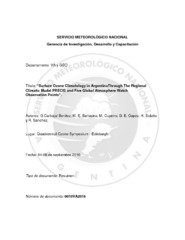Mostrar el registro sencillo del ítem
Surface Ozone Climatology in ArgentinaThrough The Regional Climatic Model PRECIS and Five Global Atmosphere Watch Observation Points
| dc.contributor.author | Carbajal Benítez, Gerardo | |
| dc.contributor.author | Barlasina, María Elena | |
| dc.contributor.author | Cupeiro, Manuel Ángel | |
| dc.contributor.author | Copes, Gustavo Emmanuel | |
| dc.contributor.author | Salutto, Hernán José | |
| dc.contributor.author | Sanchez, Ricardo | |
| dc.date.accessioned | 2016-10-24T15:43:16Z | |
| dc.date.available | 2016-10-24T15:43:16Z | |
| dc.date.issued | 2016-09-04 | |
| dc.identifier.uri | http://hdl.handle.net/20.500.12160/74 | |
| dc.description | Resumen de la presentación realizada en el Quadrennial Ozone Symposium, celebrado del 04 al 09 de septiembre de 2016 en la ciudad de Edimburgo, Escocia. | es |
| dc.description.abstract | The surface ozone is a reactive gas, considered as a greenhouse gas that has as source the emission in cities and industrial areas. In less proportion is produced by natural sources. When the surfaces ozone is not affected by nearby anthropogenic sources, it is known as background ozone. The main issue, in order to know the ozone transportation and impacts in the South Hemisphere, is due to the lack of measurement points. For this reason, this study aims to establish a surface ozone climatology in Argentina by the Regional Climatic Model (RCM) PRECIS (Providing Regional Climates for Impacts Studies). With this model, the resolution of Reanalysis ERA40 data is increased from 2.5ºx 2.5º to 0.44ºx 0.44º (lat.- long.) and validating with five measurement points. The measurement points are: La Quiaca (22 09’0”S 65 34’3”W) height 3442 m. a. s. l, Pilar (31 66’66”S,63 88’33”W) height 338 m. a. s. l, San Ju:lián (49 30’26”S, 67 82’23”W) height 58 m. a. s. l. Ushuaia (54 85’0S, 68 31’0 W) height 18 m. a. s. l. and Marambio (64 24’0 S, 56 62’W) height 198 m. a. s. l. Some results show trends in the observations. The positive trends are significant, just San Julián Station present a negative slope and no significant. The data series are cyclic and seasonal, showing maximum sin summer and minimums in winter. In Ushuaia, the seasonal cyclic shows the maximum in winter and the minimum in summer, due to the transportation effect prevails over the photochemical. This behavior is similar to Marambio, that present perturbations during the entire spring, due to ozone depletion episodes (ODE’s) related to bromine oxides. The annual means from all this observation points can be compared with the other GAW stations. The obtained results, have begun researches about impact and mitigation, for example the damage causes over the crops or in public health producing millionaire losses. | es |
| dc.language.iso | eng | es |
| dc.publisher | Servicio Meteorológico Nacional | es |
| dc.subject | OZONO SUPERFICIAL | es |
| dc.subject | ARGENTINA | es |
| dc.subject | MODELO CLIMÁTICO REGIONAL PRECIS | es |
| dc.subject | PUNTOS DE OBSERVACIÓN | es |
| dc.subject | LA QUIACA | es |
| dc.subject | PILAR | es |
| dc.subject | USHUAIA | es |
| dc.subject | MARAMBIO | es |
| dc.subject | SAN JULIAN | es |
| dc.title | Surface Ozone Climatology in ArgentinaThrough The Regional Climatic Model PRECIS and Five Global Atmosphere Watch Observation Points | es |
| dc.type | Other | es |
Ficheros en el ítem
Este ítem aparece en la(s) siguiente(s) colección(ones)
-
Resúmenes [113]
